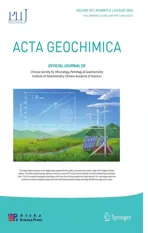Olivine and Cr-spinel as indicators of the petrogenesis and partial melting conditions of the high-MgO ultramafic volcanic rocks from NW Ad Dhala Province—Yemen
2021-09-10MukhtarNasherMuradAli
Mukhtar A.Nasher• Murad Ali
Abstract The high-MgO ultramafic volcanic rocks in the NW Ad Dhala province are classified as meimechite according to the IUGS classification scheme.This province represents the southeastern outcrops of the Yemen Volcanic Group (YVG),which constitutes part of the Afro-Arabian continental large igneous province (LIP) and located within the boundary of the Afar mantle plume.In this study,we present the chemical compositions of olivine and Cr-spinel in meimechite rocks from Bagah Village in NW Ad Dhala province,aiming to characterize the genesis and partial melting conditions and to estimate the crystallization temperatures of these high-MgO rocks.Olivine crystals are characterized by high forsterite,ranges from Mg-rich core(up to Fo89.69)to relatively Fe-rich rim(down to Fo78.57),high CaO,MgO and MnO whereas Cr-spinel crystals have high TiO2 and Cr# values ranging from 0.49 to 0.63 which indicate that they are crystallized from primary magma and are typical of volcanic olivine and Crspinel that formed in intraplate tectonic setting.Olivine and Cr-spinel compositional data and primary melt composition(MgO~23 wt.%)are compatible with the derivation of studied meimechite rocks from peridotite mantle source by small degrees of partial melting under conditions of high temperature and pressure at great depths,mostly within the garnet stability field.Also,these data provide a compelling indicator for the important role of upwelling Afar mantle plume in the genesis of these high-MgO ultramafic volcanic rocks.Finally,based on the different olivine-liquid equilibrium methods and Al-in-olivine thermometer approach the estimated crystallization temperature ranges from 1450 to 1490 °C,and mantle potential temperature (Tp) ranges from 1617 to 1677 °C,at high pressure(3–4.8 GPa).These high temperatures substantiate the existence of the Afar thermal mantle plume and its important role in the genesis of the studied meimechite rocks.
Keywords Olivine · Cr-spinel · High-MgO ultramafic volcanic rocks · meimechite · Afro-arabian LIP · Yemen
1 Introduction
The Afro-Arabian continental floods province is one of the Phanerozoic large igneous provinces(LIPs)that is covering extensive areas extend from SW Ethiopia to western Yemen and SW Saudi Arabia passing through Djibouti and Eritrea (Fig.1a).The formation of this continental LIP is associated with the continental rifting and formation of the Red Sea and the Gulf of Aden basins due to the emergence of the Afar mantle plume and the movement of the Arabian plate away from Africa in the NE direction(e.g.Joffe et al.1987;Mohr et al.1988;Jestin et al.1994;Mattash 1994;Al-Kadasi 1994;Davison et al.1994;Baker et al.1996a;Chu et al.1998;Ghebreab 1998;Ukstins et al.2002,2005;Bosworth et al.2005;Mattash et al.2013).
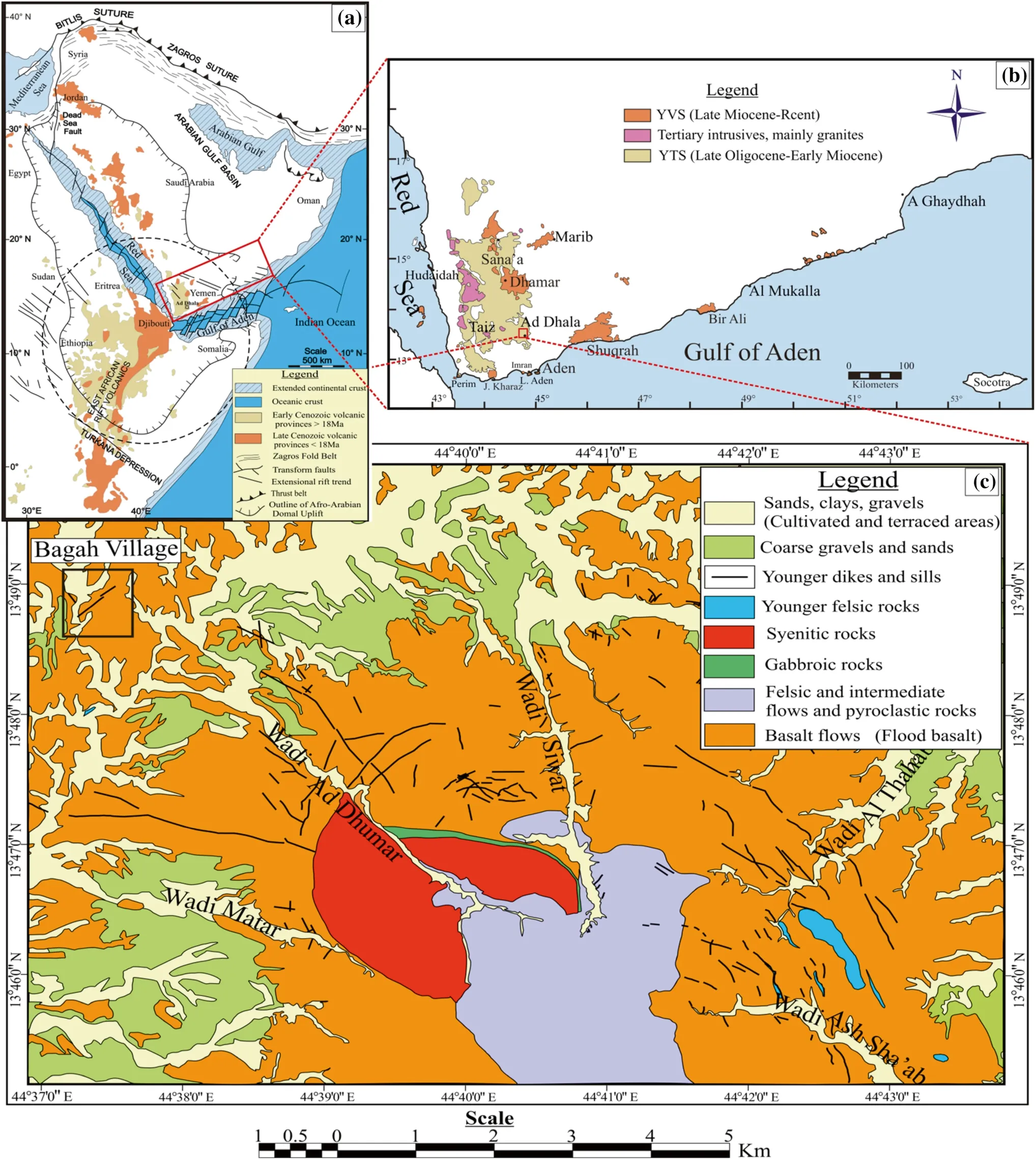
Fig.1 a Distribution of continental Cenozoic volcanism in the Red Sea and Gulf of Aden region [modified after Ukstins et al.(2005) and Bosworth et al.(2016);other data from Almond(1986),Davison et al.(1994),Baker et al.(1996a),Ghebreab(1998),Ukstins et al.(2002),and Bosworth et al.(2005)].The circle represents the boundary of Afar hot spot of White et al.(1989)where the Afro-Arabian triple junction forms the center of the circle with a radius of 1000 km.;(b)Schematic geological map showing the distribution of major geological units of the Yemen Trap Series(YTS),Yemen Volcanic Series(YVS)and Tertiary Intrusions(modified after Mattash 1994 and Mattash et al.2013);(c)Geological map of NW Ad Dhala province shows the location of study area (modified after Nasher 2010)
Within the volcanic rocks of the LIPs,the occurrence of high-MgO volcanic rocks such as picrite,ferropicrite,komatiite,and meimechite is relatively uncommon,however,they are reported to be found in many continental LIPs such as the Siberian LIP (e.g.,Arndt et al.1995;Kogarko et al.2000;Carlson et al.2006;Elkins-Tanton et al.2007;Sobolev et al.2009;Vasil’ev et al.2014;Ivanov et al.2018),the Karoo LIP (e.g.Heinonen et al.2010,2013,2017),the Emeishan LIP (e.g.Zhang et al.2006;Kamenetsky et al.2012;Munteanu et al.2017),the Deccan LIP(e.g.,Krishnamurthy et al.2000;Melluso et al.2006),the Afro-Arabian continental flood basalt LIP(Beccaluva et al.2009;Desta et al.2014;Natali et al.2016;Nasher et al.2020),and the Caribbean LIP (e.g.Herzberg et al.2007;Re´villon et al.2000).The occurrence of these primitive high-MgO volcanic rocks is of great importance as they provide information about the nature and composition of mantle source,the partial melting conditions,and the processes that contributed to the formation of these rocks (e.g.Arndt et al.1995;Gibson et al.2000;Zhang et al.2005,Sobolev et al.2009;Desta et al.2014;Heinonen et al.2015;Munteanu et al.2017;Shellnutt et al.2018),and hence,lead us to a better understanding about the origin and formation of these continental LIPs and their relation to upwelling hot mantle plumes.
In this paper,we present new geochemical data regarding the compositions of olivine and Cr-spinel from the high-MgO ultramafic volcanic rocks (meimechite rocks) which have been recorded in the NW Ad Dhala province within the volcanic rocks of the Yemen Volcanic Group (YVG).We use this mineral pair as an indicator of the genesis and partial melting conditions and to estimate the crystallization temperatures of these high-MgO ultramafic volcanic rocks.
The main advantage of using olivine and Cr-spinel is that they are the earliest minerals to crystallize from mantle-derived magmas and,therefore,acts as a valuable indicator for the primary magma composition,mantle source mineralogy,and partial melting conditions (e.g.Arai 1994;Zhang et al.2005,2006;Sobolev et al.2007;Coogan et al.2014;Desta et al.2014;Heinonen et al.2015;Howarth et al.2017;Howarth.2018;Nekrylov et al.2018;Jin et al.2019).Moreover,the composition of Cr-spinel is considered a powerful petrogenetic and geotectonic indicator in ultramafic and mafic rocks(Irvine 1967;Dick et al.1984;Arai 1992,1994;Liipo et al.1995;Barnes and Roeder,2001;Kamenetsky et al.2001;Nekrylov et al.2018).
1.1 Geological overview
The volcanic rocks and their associated intrusions that are exposed in the western province of Yemen (Fig.1b) and dated from late Oligocene to Recent (e.g.Menzies et al.1990;Davison et al.1994;Baker et al.1996a;Coulie´ et al.2003;Bosworth et al.2005,Mattash et al.2013,2014) are termed as a Yemen Volcanic Group (YVG) (Robertson Group plc 1992;al-Kadasi 1994;Davison et al.1994;Mattash 1994;Beydoun,et al.1998).The volcanic rocks of the YVG constitute part of the widespread Afro-Arabian continental flood basalt LIP and are located within the boundary of the Afar mantle plume(Fig.1a).The rocks of YVG are divided into older Late Oligocene-Early Miocene Yemen Trap Series (YTS) and younger Late Miocene-Recent Yemen Volcanic Series (YVS) (Mattash 1994;Beydoun,et al.1998) (Fig.1b).
The Yemen Trap Series (YTS) represents the pre-to syn-rift volcanism (Mattash 1994;Bosworth et al.2005;Mattash et al.2013,2014) and display a good bimodal geochemical distribution composed of mainly mildly alkaline basaltic rocks and peralkaline rhyolite with associated ignimbrite,tuffs and ash flows.Intermediate rocks(trachyte and less frequently andesite)are also reported but they have limited thickness and aerial extents (Manetti et at.,1991;Chiesa et al.1989;Baker et al.1996b;Davison et al.1994;Mattash 1994;Al-kadasi 1994;Chazot et al.1995;Beydoun et al.1998;Zumbo et al.1995;Ukstins et al.2005;Nasher 2010).
The study area is located at the NW Ad Dhala province(Nasher et al.2020) within the southeastern exposures of the Late Oligocene-Early Miocene Yemen Trap Series(YTS) (See Fig.1b).The rock units that cover this area(Fig.1c) are classified into three groups (Nasher 2010):1)the main volcanic pile which entirely covers the entire study area and consists mainly of mafic flows,composed essentially of flood basalts with basaltic pyroclastic intercalations,with subordinate felsic rhyolitic flows and pyroclastics (ignimbrite and tuff),and occasionally intermediate flow units (trachyandesite and latite);2) the Tertiary intrusions that penetrate the rocks of the main volcanic pile and are composed of gabbro,syenite and monzodiorite bodies;and 3)younger dikes,sills,flows,and plugs which crosscut the older volcanic rocks and their associated intrusions and are composed of ultramafic,mafic and felsic rocks.
The studied high-MgO ultramafic volcanic rocks have been recorded for the first time in Bagah Village at the NW Ad Dhala province by Nasher et al.(2020).These rocks are characterized by their high MgO(23.98–25.47 wt.%),Mgnumber (79.40–80.0),TiO2(1.32–1.48 wt.%),low SiO2(43.71–44.26 wt.%),Na2O+K2O (1.15–1.60 wt.%) and high concentrations of compatible elements [Cr(2426–2976 ppm),Ni (939–1115 ppm),Co (98–115 ppm)and V (293–362 ppm)] with overall enrichment in an incompatible and light rare earth elements (LREEs) [(La/Yb)N=5.99–6.46] (Nasher et al.2020,Table 1).These rocks are classified as meimechite based on the IUGS classification scheme of the high-Mg volcanic rocks (Le Bas 2000) and this is the first reported meimechite rocks throughout the volcanic rocks of the western Yemen volcanic province and the Afro-Arabian continental flood province (Nasher et al.2020).Furthermore,they (op.cit)classified these rocks as high-Ti type (Ti/Y=673–801)(Table 1) (Xu et al.2001;Xiao et al.2004;Kamenetsky et al.2012) and assigned them to HT1 type (the first high-Ti basalts) (Pik et al.,1998) corresponding to the Ethiopian-Yemeni continental flood basalts (CFB) zonalarrangement reported in the literature (Beccaluva et al.2009;Desta et al.2014;Natali et al.2016).
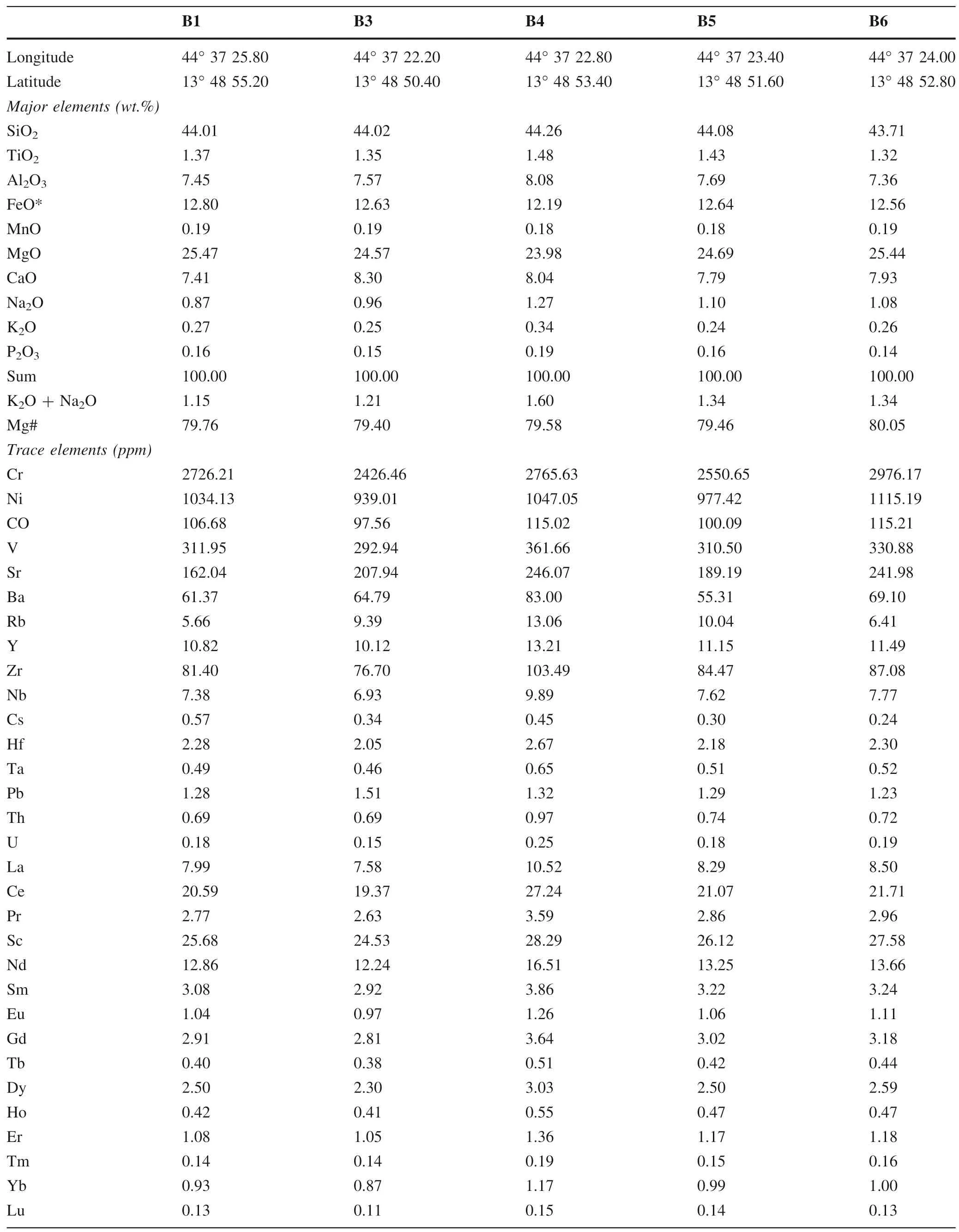
Table 1 Major and trace elements compositions form the studied meimechite rocks from NW Ad Dhala Province—Yemen [data published in Nasher et al.(2020)]

Table 1 continued
Worth mentioning,the studied high-MgO ultramafic rocks are a part of the Afro-Arabian continental LIP and should be studied in the context of the regional tectonomagmatic scenario at the conjugate rifted margins in Yemen and Ethiopia.The comparison of studied meimechites with other high-MgO volcanic rocks within the Afro-Arabian continental LIP and their relation to the upwelling Afar thermal plume have been discussed in more detail elsewhere (Nasher et al.2020),but we present a brief summary here for clarity:the study area is located at the periphery of inferred Afar plume away from the axial zone(Beccaluva et al.2009,and Natali et al.2016) and the major and trace elements data from the studied meimechite rocks are consistent with the generation of these rocks from mantle-derived melts that are closely related to upwelling Afar plume beneath the study area,similar to other high-MgO volcanic rocks within the Afro-Arabian continental LIP in spite of the different modes of formation and different spatial distribution relative to the proposed boundaries of Afar plume.These melts rapidly ascent through the Arabian lithosphere through major deep-seated NW–SE and NNE–SSW trending faults related to the formation of Ad Dhala Graben on which the study area is situated and related to the Tertiary rifting and formation of the Red Sea and the Gulf of Aden basins(e.g.Tard et al.1991;Huchon et al.1991,2003;Robertson Group plc 1992;Beydoun et al.1998).For more and detailed information and discussion regarding the studied meimechite rocks and their comparison with other high-MgO volcanic rocks within the Afro-Arabian continental LIP the reader can be referred to Nasher et al.(2020).These meimechite rocks compared well with other well documented meimechites rocks(Nasher et al.2020) particularly those from the Vestfjella area of the Karoo large igneous province (KLIP) (e.g.Heinonen et al.2010;Heinonen et al.2017) and the Yanbian Terrane of the emeishan large igneous province(ELIP) (Munteanu et al.2017) but they are slightly different from the standard meimechite rocks of the Meimecha-Kotui region of the siberian large igneous province(SLIP) (Arndt et al.1995;Elkins-Tanton et al.2007;Sobolev et al.,2009;Vasil’ev et al.2014;Ivanov et al.2018).These differences can be briefly expressed in terms of major elements where the studied meimechites have low TiO2with high Al2O3,and trace elements.Also,both rocks show similar normalized trace and rare earth elements(REEs) patterns but the studied meimechites have lower concentrations in all incompatible and light REEs.For further details and discussion regarding this point,the reader can be referred to Nasher et al.(2020).
1.2 Field and petrographic study
The studied high-MgO ultramafic volcanic rocks (meimechite)that have been recorded in Bagah Village at the NW Ad Dhala Province are occurring as a dike that crosscuts the older flood basalt flows (Nasher et al.2020)(Fig.2a).This dike attains thickness up to 8 m and can be traced tens of meters in the NE–SW direction.It has a black to brownish–black color and is characterized by coarse dark green olivine phenocrysts embedded in a fine-grained groundmass.Mostly,this dike has finer and fresher chilled peripheries compared to its central part and are sometimes slightly altered and dissected by small veinlets filled by secondary minerals.
Microscopically,these rocks have porphyritic texture composed of olivine phenocrysts and microphenocrysts set in hypocrystalline groundmass(Fig.2b and c)consisting of olivine,pyroxene,opaque,glass materials,and rarely plagioclase with apatite as an accessory mineral.Olivine occurs as euhedral to subhedral phenocrysts and microphenocrysts with the presence of some olivine megacrysts (>1 cm) (Fig.2d and e).Many crystals are variably altered,particularly along the cracks and peripheries,to serpentine,‘‘iddingsite’’(reddish-brown),chlorite,and opaques(See Fig.2d).Pyroxene occurs as fine-grained fresh crystals in the groundmass,however,some crystals are altered to epidote or chlorite.Plagioclase occurs as finegrained,mostly,fresh laths in the groundmass.Glass material is partially altered to brown palagonite.
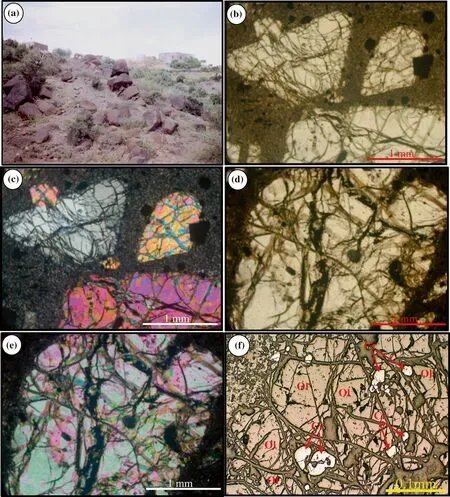
Fig.2 a:Field view of the studied ultramafic dike which strike in the NE-SW direction.Note the big bolder from the dyke body,photo looking E;b,c:Photomicrographs of meimechite sample composed of olivine phenocrysts embedded in hypocrystalline groundmass(porphyritic texture).Cr-spinel grains are included within the phenocrysts and disseminated throughout the ground mass,crossed-polarized light (XPL) and plainpolarized light(PPL);d,e:highly cracked olivine megacryst contains Cr-spinel grains and altered along the cracks and peripheries to serpentine(green),iddengsite (reddish brown) and opaques (black),PPL and XPL; f: large highly cracked olivine phenocryst (Ol) contains small fresh grains of Cr-spinel (Cr),reflected light (RL) without analyzer
Opaque minerals are represented mainly by chromite(Cr-spinel) with subordinate crystals of magnetite,ilmenite,and rarely sulphides.Cr-spinel occurs as small to coarse (from <10 μm up to 300 μm in size) subhedral to anhedral equant crystals included within the olivine phenocrysts (Fig.2f) and disseminated throughout the groundmass (See Fig.2b).Cr-spinel crystals that are included within olivine crystals are fresh but those in the groundmass are mostly encrusted by magnetite forming zoned crystals.Magnetite and ilmenite occur as single finegrained equant to prismatic crystals disseminated throughout the rock samples.
1.3 Analytical Techniques
Olivine phenocrysts,microphenocrysts,and chromite grains,particularly those included within olivine phenocrysts,from the studied meimechite rocks were analyzed for major elements using (JEOL JXA-8800R) electron probe microanalyzer(EPMA)at the Centre for Cooperative Research of Kanazawa University,Japan.The analytical conditions were 20 kV acceleration voltage,20 nA probe current,and 3 μm probe diameter,and X-ray was counted for 10 s for all elements.JEOL software using ZAF corrections was also employed.Natural and synthetic minerals were used as calibration standards (JEOL Kanazawa STD1).The following standards were used:as Q17-quartz for Si,O16-corundum for Al,O19-eskolaite for Cr,M6-fayalite for Fe,O15-periclase for Mg,O20-manganosite for Mn,M8-wollastonite for Ca,M3-jadeite for Na,M13-KTiPO5 for K,Ti and O24-pentlandite for Ni.Secondary standards (olivine,clinopyroxene,spinel,and alkali feldspar) were analyzed repeatedly to ensure accuracy for the major elements.Details of EPMA were described in Morishita et al.(2003).Electron microprobe analyses were carried out in situ on polished thin sections of studied meimechite samples.Thin sections were prepared for typical samples,considering the homogeneity of mineral distribution in the hand specimens.All Fe in olivine was assumed to be ferrous,ferrous and ferric iron contents in Cr-spinels were calculated based on spinel stoichiometry.Mg# is calculated as the Mg/(Mg+Fe2+) atomic ratio,and Cr# is calculated as the Cr/(Cr+Al) atomic ratio.
2 Results
The results of the electron probe microanalyses(EPMA)of representative olivine and Cr-spinel grains from the studied meimechite rocks are listed in Tables 2 and 3.
2.1 Composition of olivine
Olivine crystals (phenocrysts and microphenocrysts with some megacrysts) in studied meimechite rocks are characterized by high and variable forsterite values [Fo=100*Mg/(Mg+Fe) atomic ratio] ranging from 78.57 to 89.69,high CaO (0.32–0.44 wt.%) and MnO (0.15–0.36)with relatively high NiO (0.17–0.33 wt.%),where the composition of olivine crystals shows variations within a single sample.The olivine crystals show weak normal zoning characterized by Mg-rich core (ranges from Fo82to90with the majority between Fo86and88) to relatively Fe-rich rim (down to Fo78.57) (Fig.3).MnO is enriched in the rims (Fig.3c) whereas CaO and NiO (not shown) are not showing characteristic variations between the crystal’s cores and rims.Such weak normal zoning in olivine has been also reported in meimechite rocks from Meimecha-Kotui province (Elkins-Tanton et al.2007;Ryabchikov et al.2009;Sobolev et al.2009).The high CaO contents (up to 0.44 wt.%) of olivine crystals are typical of volcanic olivine(cf.Simkin et al.1970;Heinonen et al.2010)indicating a magmatic origin,i.e.,they are not mantle-derived xenocrysts but have crystallized from a melt (Simkin et al.1970;Larsen et al.2003;Zhang et al.2005,2006;Desta et al.2014;Heinonen et al.2013,2015,2018;Munteanu et al.2017) where possible xenocrysts would have a very low content of CaO and Cr2O3(Larsen et al.2000).On the other hand,based on the textural and petrographic data,the absence of pyroxene phenocrysts and microphenocrysts suggests that the differentiation of the primary magma taken place in a deepseated magma chamber through the fractional crystallization of the olivine and Cr-spinel (Munteanu et al.2017).Subsequently,the olivine phenocrysts transported by the resultant evolved melts with which they did not equilibrate(Kamenetsky et al.2012).The melt migrated through the crust and Arabian lithosphere rapidly beneath the study area with no or negligible crustal assimilation en route to the surface (Nasher et al.2020).The ascending pathway was largely facilitated through NW–SE and NNE-SSW trending faults related to the continental breakup and formation of the Red Sea and the Gulf of Aden basins during the Tertiary (e.g.,Tard et al.1991;Huchon et al.1991,2003;Beydoun et al.1998).
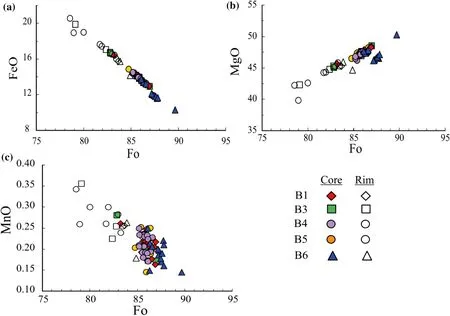
Fig.3 Fo vs.MgO,FeO and MnO plots showing the core versus rim compositions of the olivine phenocrysts and microphenocrysts from the studied meimechite rocks
The composition of olivine from the studied meimechites is similar to that of olivine of meimechite rocks from the Meimecha-Kotui area of the Siberian LIP(Arndt et al.1995;Kogarko and Rybchikov 2000;Carlson et al.2006;Soblove et al.2009),the Vestfjella area of the Karoo LIP(Heinonen et al.2010,2017)and the Yanbian area of the Emeishan LIP (Munteanu et al.2017) (Fig.4).Noteworthy,the NiO and Cr2O3content of olivine from the studied meimechites overlaps that of meimechites from other LIPs,particularly those from Meimecha-Kotui(Arndt et al.1995;Soblove et al.2009) but appears lower compared to that from Vestfjella area (Heinonen et al.2010,2017) (Fig.4e and f).In general,these variations in the composition of olivine from the studied meimechites and other meimechites can be attributed to the variations in the source lithology and partial melting conditions.However,the NiO content of olivine from the studied meimechite is consistent with their derivation from peridotite mantle source(e.g.,Sobolev et al.2007;Heinonen et al.2017;Howarth et al.2017)and is mostly consistent with high temperature melting(e.g.,Howarth et al.2017)and possibly high water contents in such peridotite source (e.g.,Heinonen et al.2017) (see Sect.6.2 and 6.3).
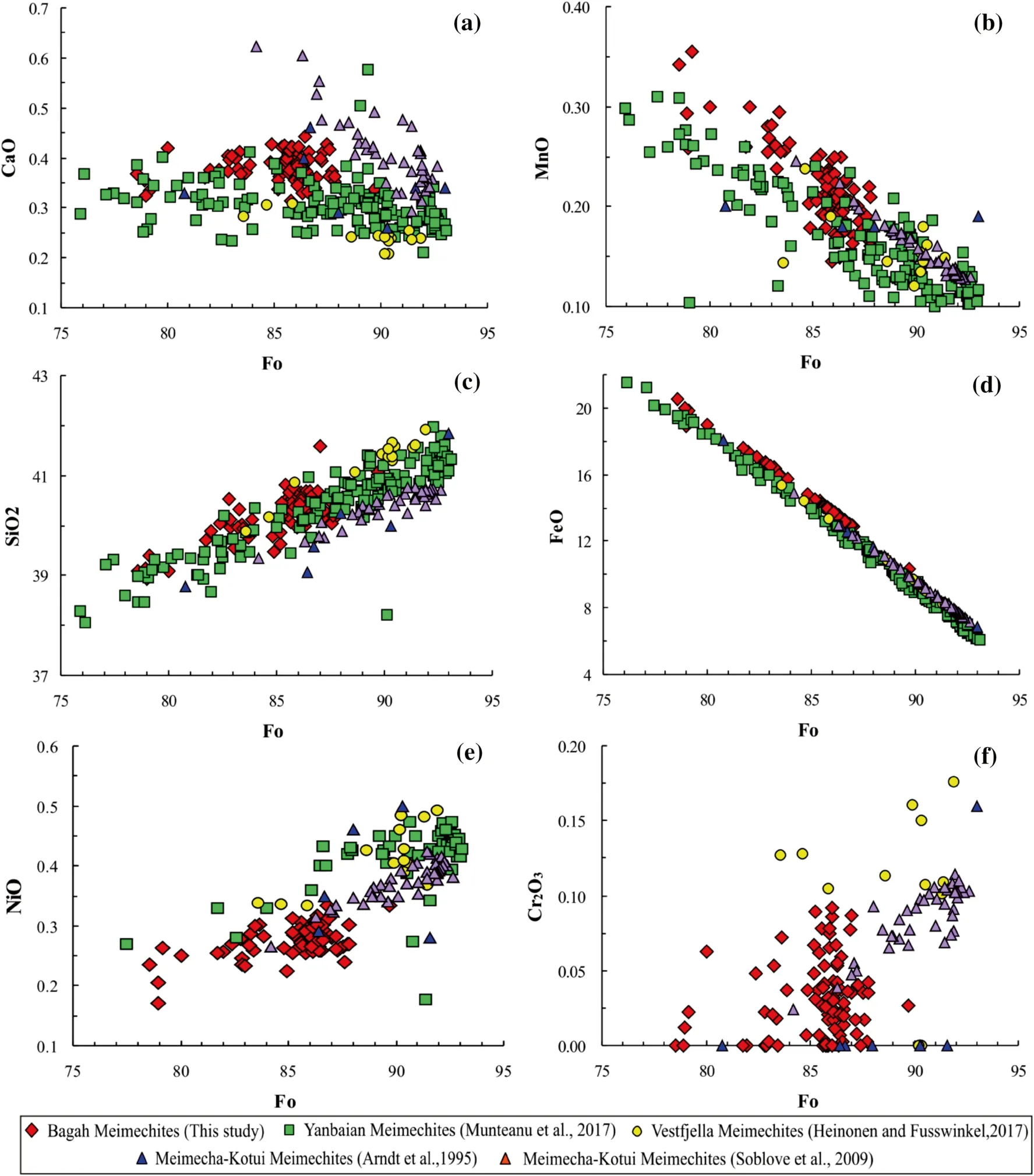
Fig.4 Composition of olivine from studied meimechites.Olivine composition data from meimechite rocks from the Maimecha-Kotui region–the Siberian LIP(Arndt et al.1995;Sobolev et al.2009),the Vestfjella region—the Karoo LIP(Heinonen et al.2017)and the Yanbian Terrane—the Emeishan LIP (Munteanu et al.2017) shown for comparison
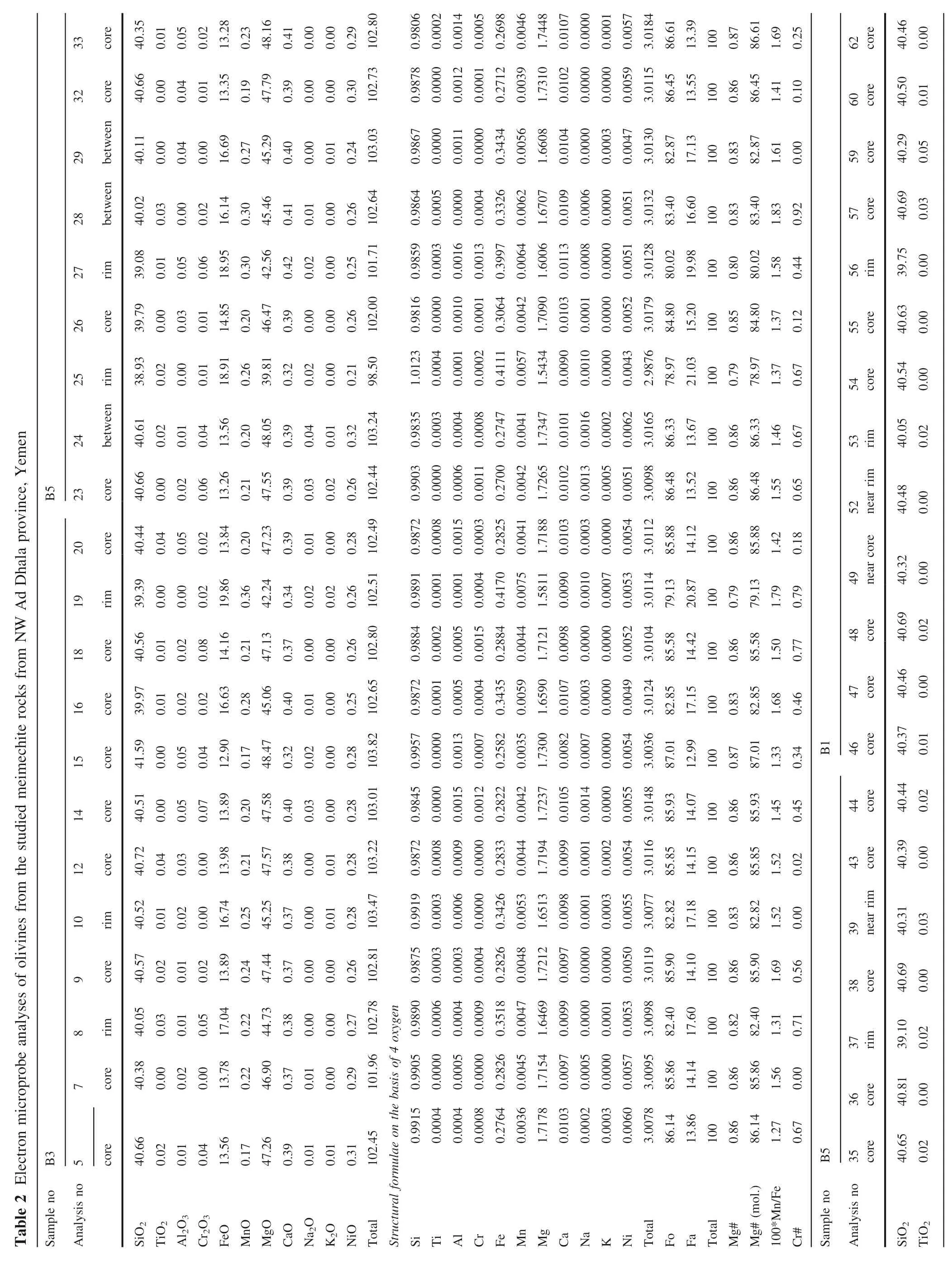
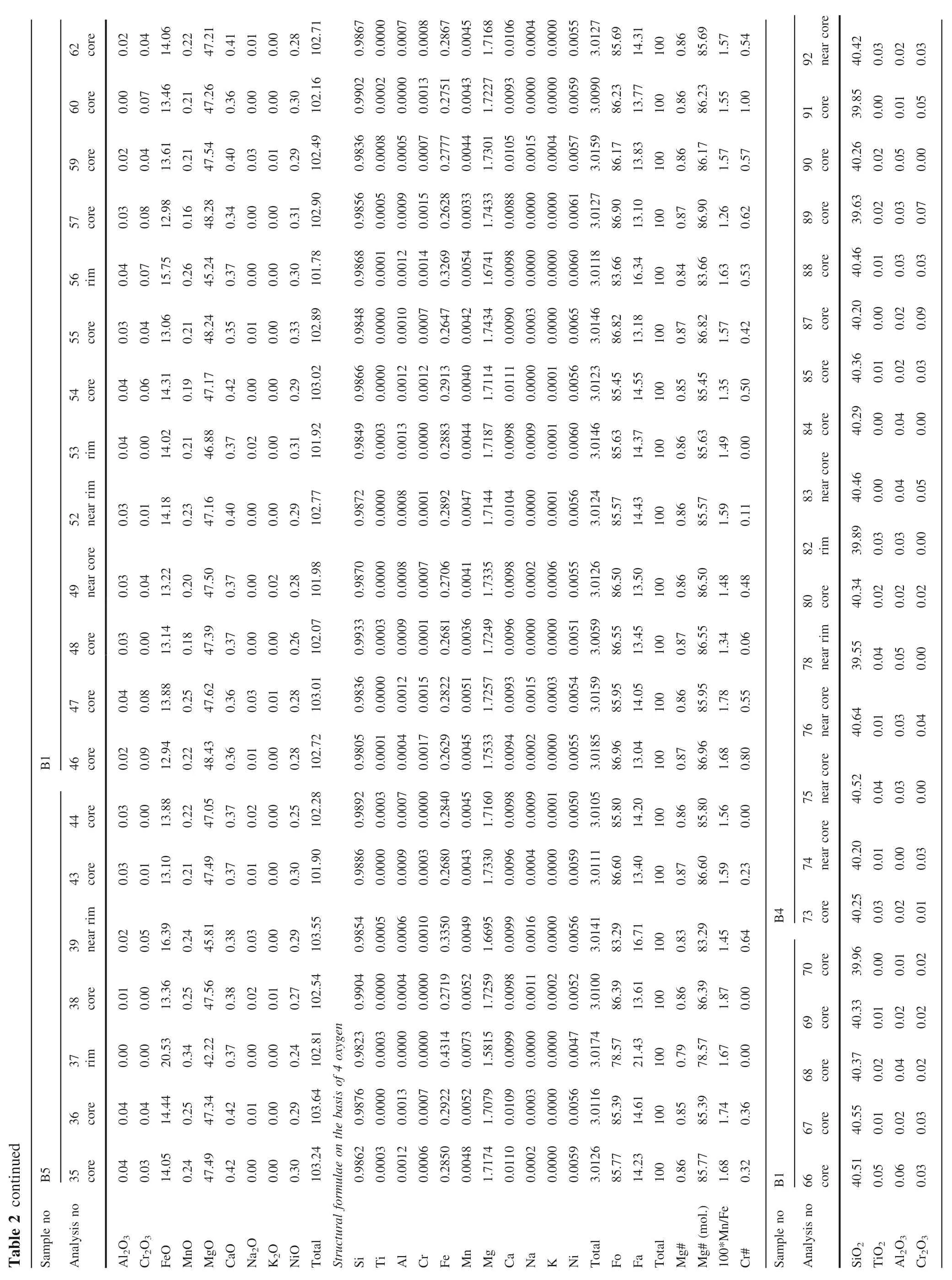
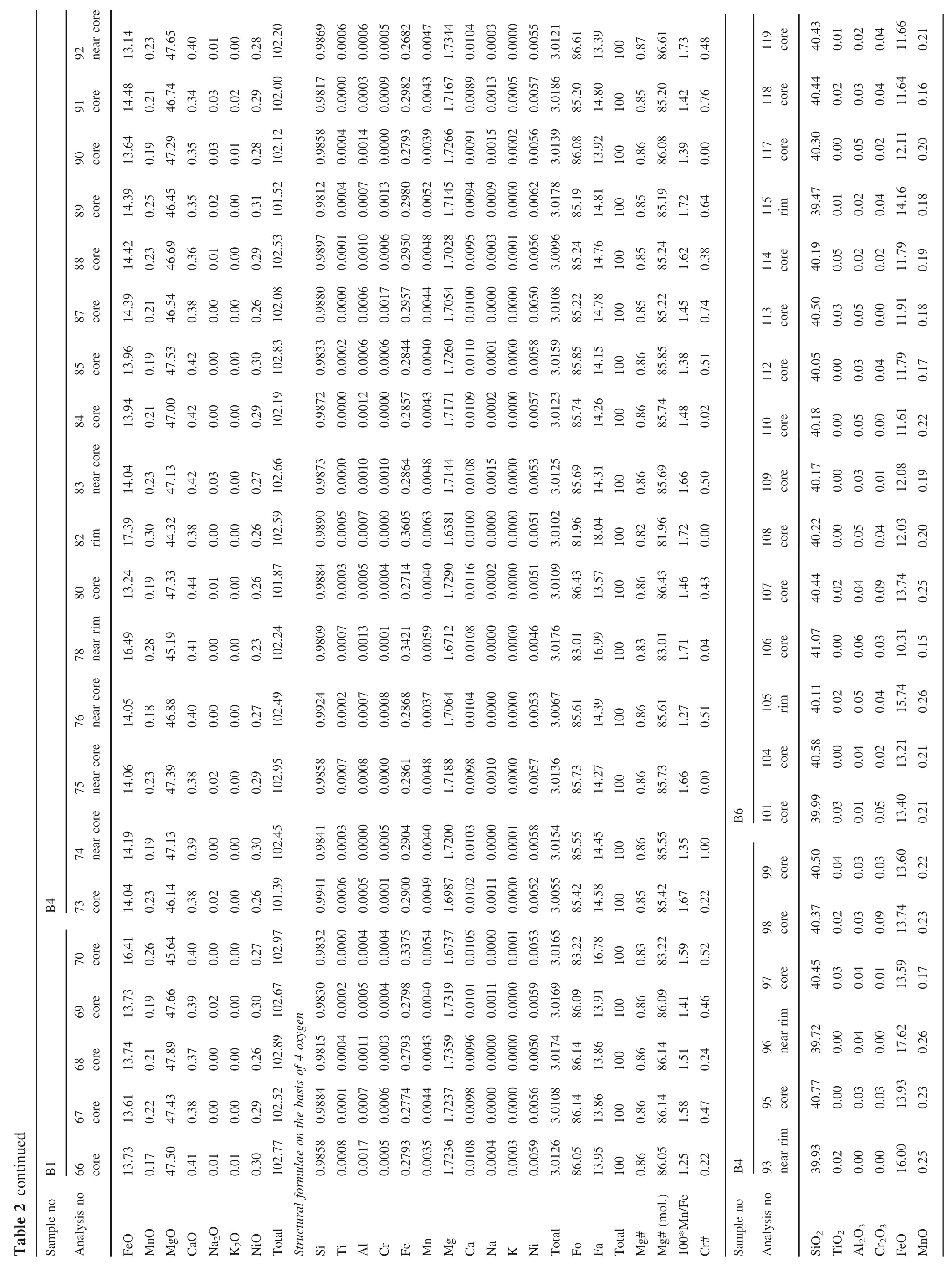
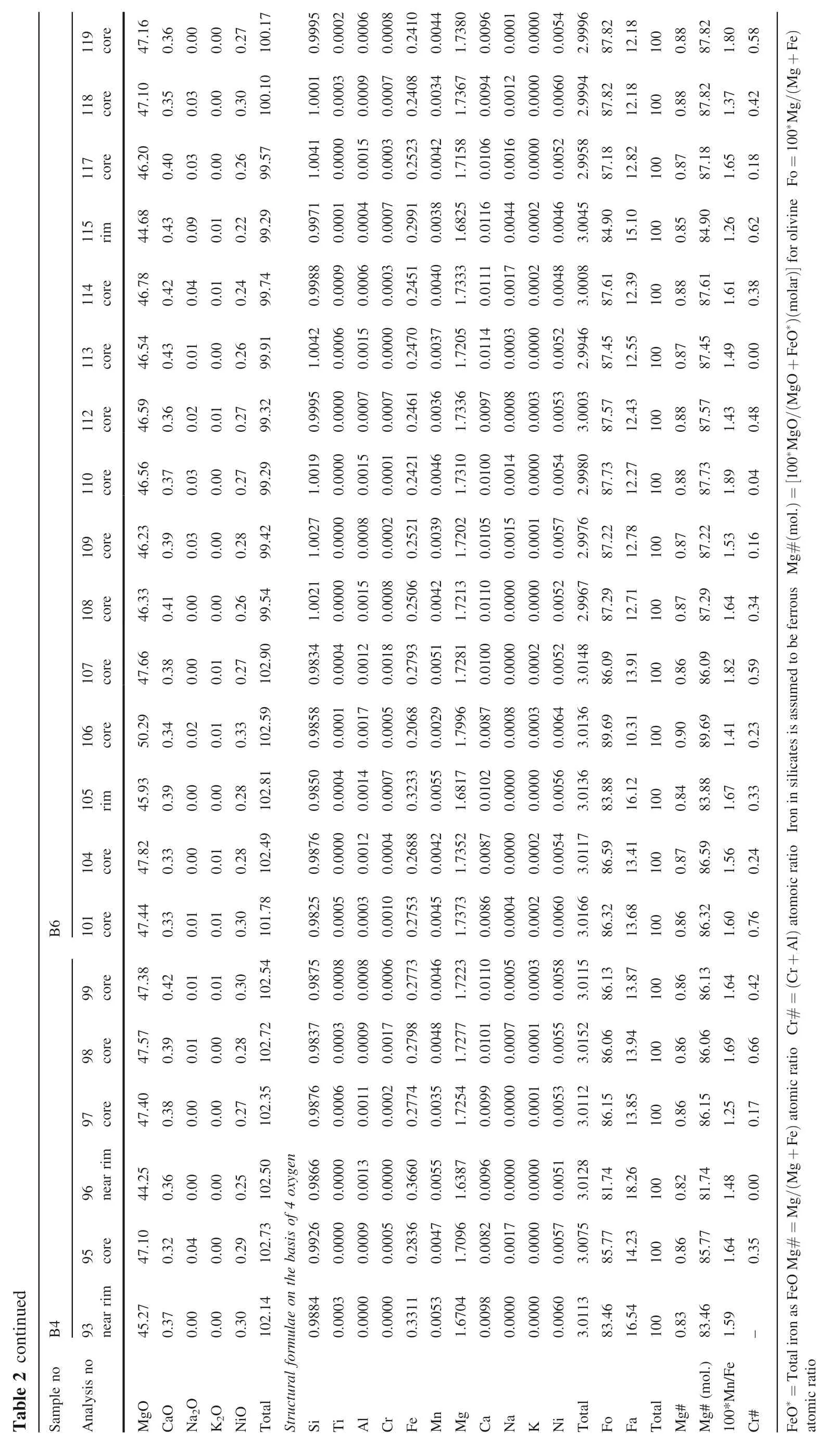
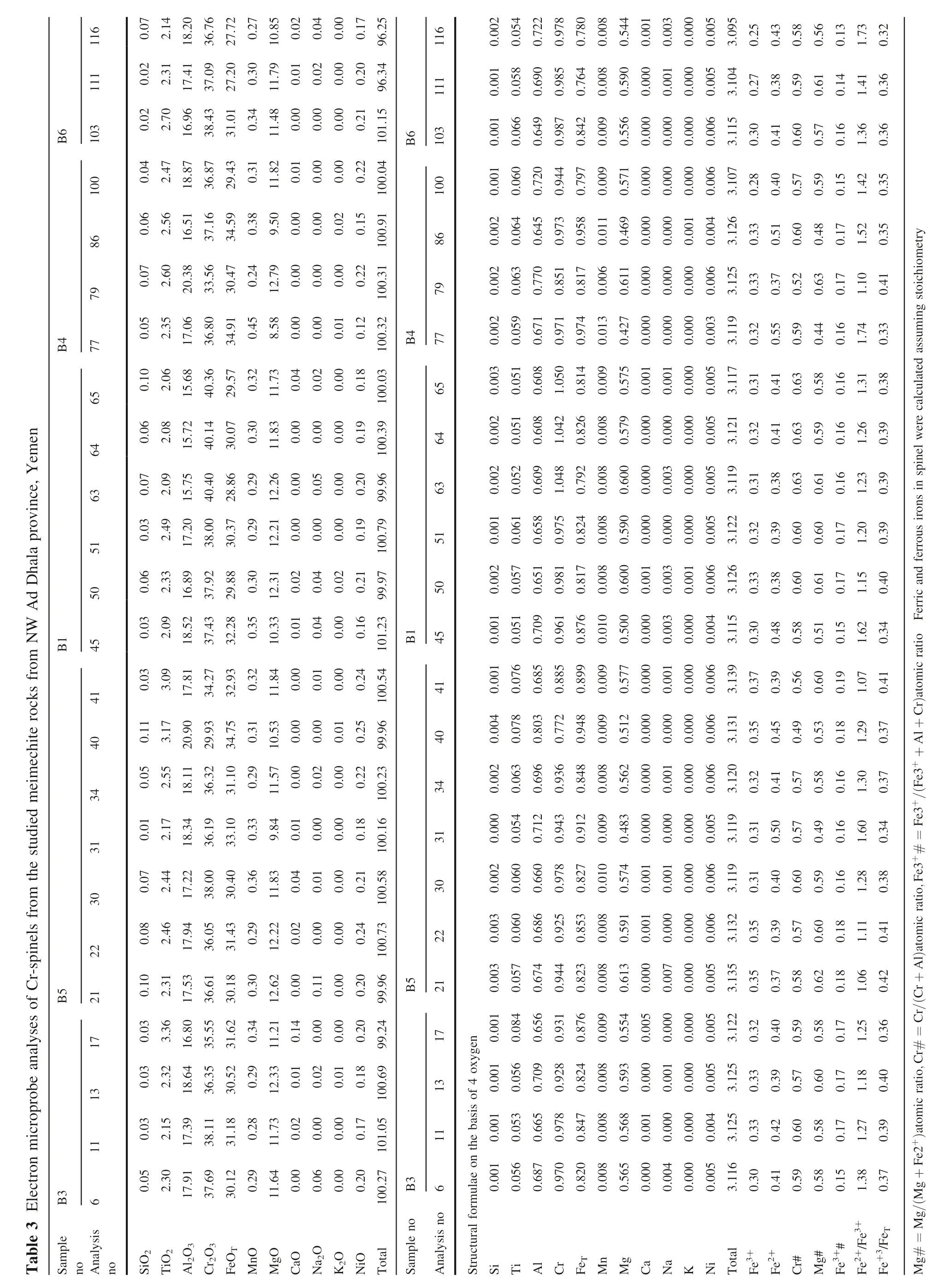
2.2 Composition of Cr-spinel
Cr-spinel crystals have Cr# values [Cr#=Cr/(Cr+Al)atomic ratio] ranging from 0.49 to 0.63;Mg# values[Mg#=Mg/(Mg+Fe2+) atomic ratio] ranging from 0.44 to 0.63;TiO2in the range of 2.06–3.36 wt.%;Cr2O3varies from 29.93 to 40.40 wt.%;FeOT=27.20–34.91 wt.%,Al2O3=15.68–20.90 wt.%,MgO=8.58–12.79 wt.% and Fe2+/Fe3+=1.06–1.74.Mostly,the analyzed Cr-spinel appears as homogenous grains without any zonation and on the Fe3+-Al-Cr triangular diagram of Stevens (1944) the majority of these grains plot in the field of Al-chromite with one-grain fall in Cr-spinel field (Fig.5a).In the following text,the term Cr-spinel is used in order to avoid conceptual confusion,regardless of composition.These Crspinels have higher TiO2than spinels in mantle peridotites(Fig.5b),which indicate that they are not xenocrysts but they are crystallized from parental magma(Heinonen et al.2015)and plotted within the field of intraplate tectonic setting in the discrimination diagram of Arai (1992)(Fig.5c).On the TiO2vs.Al2O3discrimination diagram of Kamenetsky et al.(2001)(Fig.5b)all Cr-spinel are plotted within the field of spinels in OIB.An interesting observation is that the meimechite rocks from the study area(Nasher et al.2020) and other meimechite rocks from the Meimecha-Kotuy of the Siberian LIP (Arndt et al.1995;Carlson et al.2006;Soblove et al.2009),from the Vestfjella area of the Karoo LIP (Heinonen et al.2010,2017)and from the Yanbian area of the Emeishan LIP(Munteanu et al.2017) have geochemical characteristics (e.g.,normalized trace and rare earth elements patterns and isotopic compositions) resembling that of the intraplate OIB and mostly suggesting a plume mantle source (Nasher et al.2020).
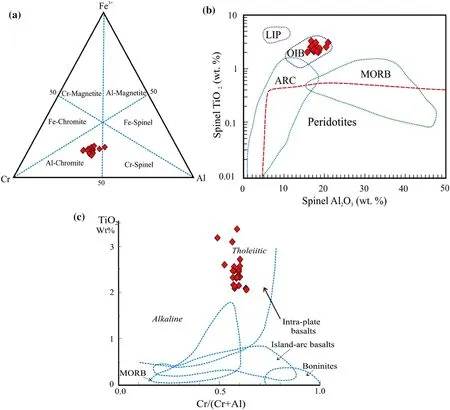
Fig.5 a Cr—Fe3+—Al diagram of Stevens (1944) of studied Cr-spinel,(b) TiO2 versus Al2O3 diagram of Kamenetsky et al.(2001) and(c) TiO2 versus Cr # diagram of Arai (1992) for Cr-spinels from the studied meimechites.Spinel discrimination fields in panel a (LIP=large igneous provinces;OIB=oceanic island basalts;MORB=mid-ocean ridge basalts;ARC=island arcs;Peridotites=mantle peridotites) are after Kamenetsky et al.(2001).Discrimination fields in panel b are after Arai (1992)
These compositions are characteristics of Cr-spinel from the studied meimechites are very similar to those of Crspinel from the Vestfjella meimechites (Heinonen et al.2010,2017) but in comparison with Cr-spinel from the Meimecha-Kotuy meimechites (Arndt et al.1995;Ryabchikov et al.2009;Panina et al.2013;Vasil’ev et al.2017),the studied Cr-spinel has low TiO2and high Al2O3contents.
3 Discussion
3.1 Original liquid composition
The composition of olivine from the studied meimechite rocks can be used to estimate the original liquid composition (primary magma).Therefore,the Mg-number of olivine[100 × MgO/(MgO+FeO*)(molar)]is plotted against bulk-rock MgO content (Fig.6).On this plot,the curves represent the compositions of olivine in equilibrium with liquids containing 8,9,10,11,12,and 13% FeO are shown.These values represent the FeO content of likely primary magmas,assuming 15%of total iron oxide is ferric(Re´villon et al.2000;Zhang et al.2005,2006).All samples fall to the right below the equilibrium curves,indicating olivine accumulation(Re´villon et al.1999,2000;Zhang et al.2005,2006).Similar olivine accumulation is observed in meimechite rocks from the Meimecha-Kotui of the Siberian LIP(Arndt et al.1998;Carlson et al.,2006;Sobolev et al.,2009),from the Yanbian terrane of the Emeishan LIP (Munteanu et al.2017) and the Vestfjella region of the Karoo LIP(e.g.,Heinonen et al.2010,2017).The most magnesian olivine phenocryst contains 90 forsterite(sample no.B6)plot close to the 13 wt.%FeO curve(Fig.6) and the estimated MgO content of the primary magma of these rocks was~22.2 wt.%.However,there are uncertainties associated with this estimation where the total error is probably close to ± 2 wt.% (Re´villon et al.,2000).On the other hand,the primary melt composition of studied meimechites can be calculated based on the composition of the most Fo-rich olivine phenocrysts-containing sample (B6) using the PRIMELT2.XLS software (Herzberg et al.2008) or the PRIMELT3 MEGA.xlsm software(Herzberg et al.2015).These calculations yielding primary melt with MgO content of about 23 wt.%(Table 4),which is in equilibrium with garnet peridotite mantle source.
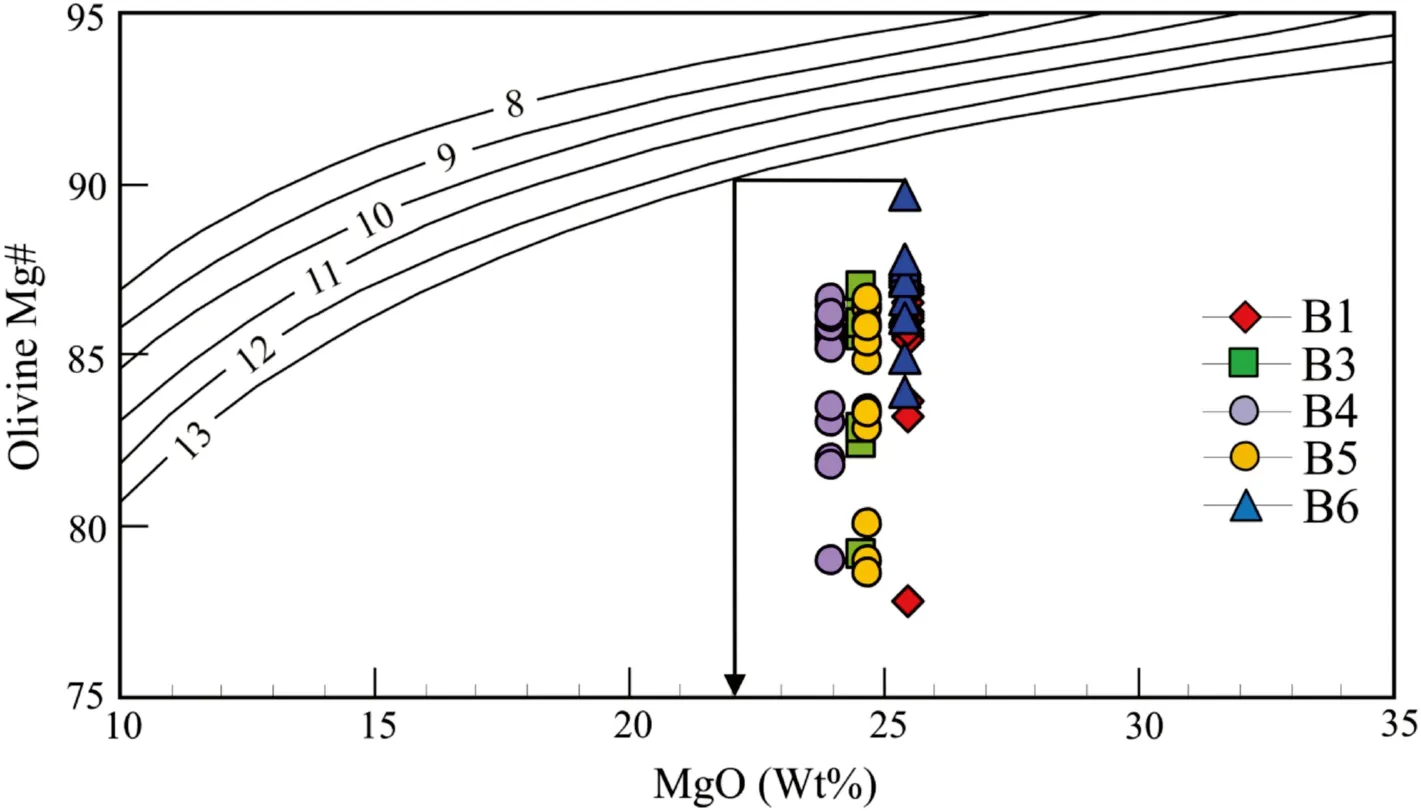
Fig.6 Mg-number of olivine versus MgO of whole rocks from studied meimechite rocks.The curves represent the relationship between liquids MgO content and the Mgnumber of olivine in equilibrium with liquids containing 8,9,10,11,12,13 wt.% FeO,assuming a Mg-Fe olivine-liquid partition coefficient of 0.31(Roeder et al.1970)
3.2 Nature of mantle source and partial melting conditions
The high contents of forsterite(ranges from Fo78.57to89.69,with the majority between Fo82and88),CaO (up to 0.44 wt.%),and MgO (up to 50.29 wt.%) of the olivine phenocrysts indicate their primitive nature and their precipitation from melts in equilibrium with peridotite mantle source (Arndt et al.1995;Sobolev et al.2007;Herzberg et al.2008;Heinonen et al.2013;Desta et al.2014).The high MgO content of the primary magma of the studied meimechites (~23 wt.%) (previous section) is a strong indicator of their derivation from a predominantly peridotite mantle source(Herzberg et al.2002;Heinonen et al.2010).Contrasting to the peridotites,experiments on pyroxenites have yielded partial melts with MgO <16 wt.% (Kogiso et al.2004;Yang et al.2013).The production of such high-Mg melts (23 wt.% MgO) can be achieved by small degrees of partial melting at high pressure;that is,depths of >130 km (Herzberg et al.1988;Herzberg 1992;Munteanu et al.2017),mostly within the garnet stability field (e.g.Walter 1998).Moreover,many authors regarded such ultramafic volcanic rocks as the primary evidence for a mantle plume origin of the large igneous province (Siberia,Karoo,and Emeishan) (e.g.Sobolev et al.2009;Shellnutt 2014;Heinonen et al.2015;Shellnutt et al.2018).
The nature of the mantle source of the studied meimechites can be defined by using PX#(13.81–0.274*MgO–CaO) parameter introduced by Herzberg et al.(2008) and adapted by Heinonen et al.(2013) using the whole-rock MgO and CaO or MgO and CaO contents of primary magma produced by accumulated fractional melting using PRIMELT3 MEGA.xlsm software (Table 4) (Herzberg et al.2015).This parameter yields negative values(PX#=-1.22 to -0.57) indicating peridotite-rich sources.Additional evidence for the derivation of these rocks from peridotite mantle source also comes from the whole rock composition using FC3MS(FeOT/CaO–3*MgO/SiO2)parameter introduced by Yang et al.(2013),where the studied meimechites yielded FC3MS values much lower than 0.65 indicating a peridotite mantle source.

Table 4 Calculated primary melt composition,crystallization temperature T and potential mantle temperature Tp of studied meimechites using the PRIMELT3 MEGA.xlsm software (Herzberg and Asimow,2015).The most Fo-rich olivine phenocryst-containing sample (B6) is used for calculation
The Mn/Fe ratio of olivine is mainly dependent on the amount of olivine in the mantle source(Jin et al.2019)and least dependent on olivine fractionation,hence it has been suggested to reflect the mineral composition of the mantle source of the primary magma (Sobolev et al.2007;Heinonen et al.2017),where the higher 100*Mn/Fe values show that the olivine was in equilibrium with the melts derived from peridotite mantle source (Sobolev et al.2007,2009;Howarth et al.2017).The 100*Mn/Fe(1.25–1.89,the majority >1.4),Ni,Ni/Mg,and Ni/(Mg/Fe) values of the most magnesian olivine cores from the studied meimechites indicate an olivine-bearing peridotite mantle source(Fig.7).This inference is consistent with the high MgO contents of the primary magma in the studied meimechites.However,the low Mn/Fe values,shown in Fig.7 are likely to reflect high temperatures and pressures of melting,and possibly high water contents in such peridotite sources (Heinonen et al.2017).The high melting temperature/pressure and water content of the mantle source have a strong effect on the partitioning of Ni and Mn (e.g.,Balta et al.2011;Niu et al.2011;Howarth et al.2017;Matzen et al.2017) where the higher melting temperatures/pressures decrease the partition coefficient of Ni between olivine and liquid (Kd(Ni)ol-liq) and increase Kd(Mn)ol-liq(Li et al.2010;Matzen et al.2017) whereas higher water content of the source increases Kd(Mn)gar-net-liq(Balta et al.2011).Noteworthy,the presence of water in the mantle source of the studied meimechites is inferred from the presence of hydrous mineral(amphibole)as the residual phase in the source region during the melting of the lithospheric mantle (Nasher et al.2020).However,the absence of amphibole within the mineralogy of studied meimechites is attributed to the dehydration melting due to the continued upwelling of the Afar plume and its thermal effects(op.cit).Accordingly,this change inwater content together with high melting temperature/pressure could explain the spread in Mn/Fe relative to typical peridotite,where the effects of these parameters on the magma Ni and Mn contents could exceed the effects caused by variations in source mineralogy (Balta et al.2011;Heinonen et al.2017;Matzen et al.2017).Additionally,the high-temperature formation of magma is also supported by the high Cr contents in the Cr-spinel (Larsen and Pederson 2000;Zhang et al.2005,2006;Desta et al.2014) whereas the relatively high Ni content in olivine supports the above partial melting conditions of water-enriched garnet-peridotite mantle source (Heinonen et al.2017).
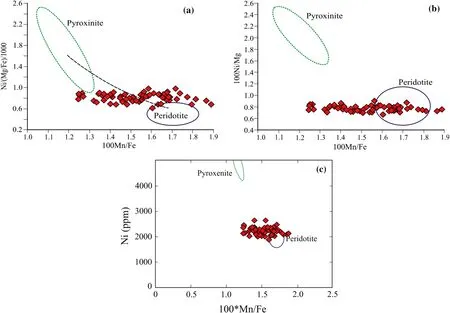
Fig.7 100*Mn/Fe versus a)100*Ni/Mg and b)Ni/(Mg/Fe)/1000(Sobolev et al.2007,2009)and c)Ni(Howarth et al.2017)diagrams for Mgrich olivine cores from the studied meimechite rocks.Solid and doted ellipse contour the fields of olivine in equilibrium with typical peridotiteand pyroxenite-derived liquids,respectively,are after Sobolev et al.(2007).Elements and their ratios are shown in ppm.Dashed line in first panel represents the mixing line of boundary components according to the model of Herzberg et al.(2002)
In summary,olivine compositions and parameters based on whole-rock compositions indicate that the studied meimechites are derived from peridotite mantle source by small degrees of partial melting under high temperature and pressure conditions at great depths,mostly within the garnet stability field.
3.3 Magma temperature
3.3.1 Crystallization Temperature (T) and Mantle Potential Temperature (Tp)
Based on the primary melt composition (Table 4),the estimated MgO content of parental magma was~22.65 wt.% and consequently the obtained eruption (1 atm)temperature(crystallization temperature)is about 1457 °C,calculated using the equationT(°C)=17.86 × MgO(wt.%)+1061 (Nisbet et al.1993).Plotting of this estimated temperature on pressure–temperature paths for primary ultramafic magmas (Herzberg et al.2002) (Fig.8)suggests an initial melting temperature (mantle potential temperature,Tp)of about 1675 °C,a pressure of about 4.8 GPa,and a depth of about 150 km.However,the estimated temperature in this approach may commonly have an error of about ± 100 °C(Zhang et al.2005)that may arise from the large errors in estimated pressure,the uncertainties in water content and oxygen fugacity(Arndt 2000),the depth of magma segregation from the source(Nisbet et al.1993),the proportion of crystals in the ascending magma,and the nature of the melting process itself (Zhang et al.2006).Likewise,approximately,similar mantle potential temperature(Tp)of about 1643 to 1685 °C(at a pressure of 3 and 4 GPa) is obtained based on olivine-liquid thermometry using the approach of Putirka et al.(2007).In this approach,we first estimated the olivine-liquid equilibration temperatures (olivine crystallization temperatures) using Eq.4 and then converted them to mantle potential temperature(Tp) using the parameters in Putirka et al.(2007).For these calculations,we used an Mg-Fe exchange coefficient between olivine and liquid,Kd(Fe–Mg)ol-liqis 0.35.The uncertainty in estimation of mean mantle potential temperature using this method is about 78 °C (Putirka et al.,2007).
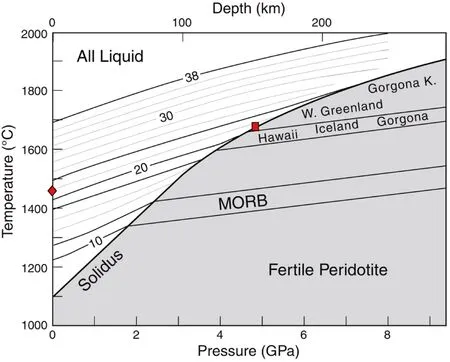
Fig.8 Adiabatic T-P paths for primary magmas produced by melting of fertile peridotite (Herzberg et al.2002).,estimated 1 atm temperature of sample no.B6;,a rough estimate of temperature and pressure at the start of melting.Numbers on paths to the left of the solidus indicate wt.% MgO of liquids.Ranges of estimated mantle pressure and temperature for Gorgona komatiites (K) and picritic basalts,West Greenland picritic lavas,modern Hawaii and Iceland,and MORB (mid-ocean ridge basalt) are from Herzberg et al.(2002)
Another approach is used to estimate the source potential temperature and pressure based on the calculated primary melt composition (Table 4) can be achieved viaT(°C)=2000[MgO/(SiO2+MgO)]+969 and ln[10P](GPa)=0.00252T– 0.12SiO2+5.027 equations(Albare´de 1992),respectively,yielding a temperature of about 1646 °C and a pressure of 3.9 GPa which are similar to the mantle potential temperature calculated using the approach of Putirka et al.(2007).A high temperature is also supported by the high Cr content of the Cr-spinel(Larsen et al.2000;Zhang et al.2006).Furthermore,the estimation of the crystallization temperature and the potential temperature of the mantle source based on the calculated parental melt composition of studied meimechite rocks (Table 4) can be achieved using the PRIMELT2.XLS software (Herzberg et al.2008) (Fe+2/FeT=0.9) which yields a crystallization temperature (primary eruption temperature) and mantle potential temperature (Tp) of about 1487 and 1617 °C respectively.Mantle potential temperature calculation using this method is commonly overestimated to about 100 °C (Herzberget al.2008).Similarly,by using PRIMELT3 MEGA.xlsm software (Herzberg et al.2015) (Fe+2/FeT=0.9),olivine liquidus temperature(crystallization temperature),and mantle potential temperature (Tp) of about 1490 and 1630 °C are obtained respectively.These high mantle potential temperature (Tp) is frequently attributed to a mantle plume source(Putirka 2005;Herzberg et al.2007).The estimation of mantle potential temperature using this approach commonly has an error of less than ± 42 °C (Herzberg et al.2015).
The recent Al-in-olivine thermometer approach(Wan et al.2008;Coogan et al.2014;Heinonen et al.2015;Xu et al.2016;Bussweiler et al.2017;Jin et al.2019)is used to estimate the crystallization temperature of studied meimechites based on the partitioning of Al between coexisting Fo-rich olivine and Cr-spinel using the calibrated equation of Coogan et al.(2014):

The estimated temperature via this approach is pressureindependent and does not require information about the parental melt composition (Wan et al.2008;Coogan et al.2014),hence,it is especially useful in determining the temperatures of CFB magmas (Heinonen et al.2015).
The most magnesian olivine phenocrysts in sample B6 is used in this calculation where this sample is approximately achieved the range of parameters of Wan et al.(2008)andCoogan et al.(2014);Cr#=0–0.69[Cr/(Cr+Al)],Fe3+≤0.15 [Fe3+/(Fe3++Cr+Al)],atomic Tispl<0.025 and spinel Fe3+/FeT=0–0.35 (See Table 3).For the calculation,the olivine and Cr-spinel compositions of sample B6 are averaged separately.The obtained crystallization temperature using this approach is about 1499 ± 25 °C.Temperature estimation using this approach commonly has an error within ± 25 °C (Coogan et al.2014),although this error range may be greater due to the analytical uncertainties and the natural variation in Alol(Heinonen et al.2015).Notably,there is a similarity between the crystallization temperature calculated using Al-in-olivine thermometer with those calculated by Herzberg et al.(2008,2015)using PRIMELT2.XLS and PRIMELT3 MEGA.xlsm software and such similarity was demonstrated by Coogan et al.(2014),Heinonen et al.(2015),andXu and Liu (2016).
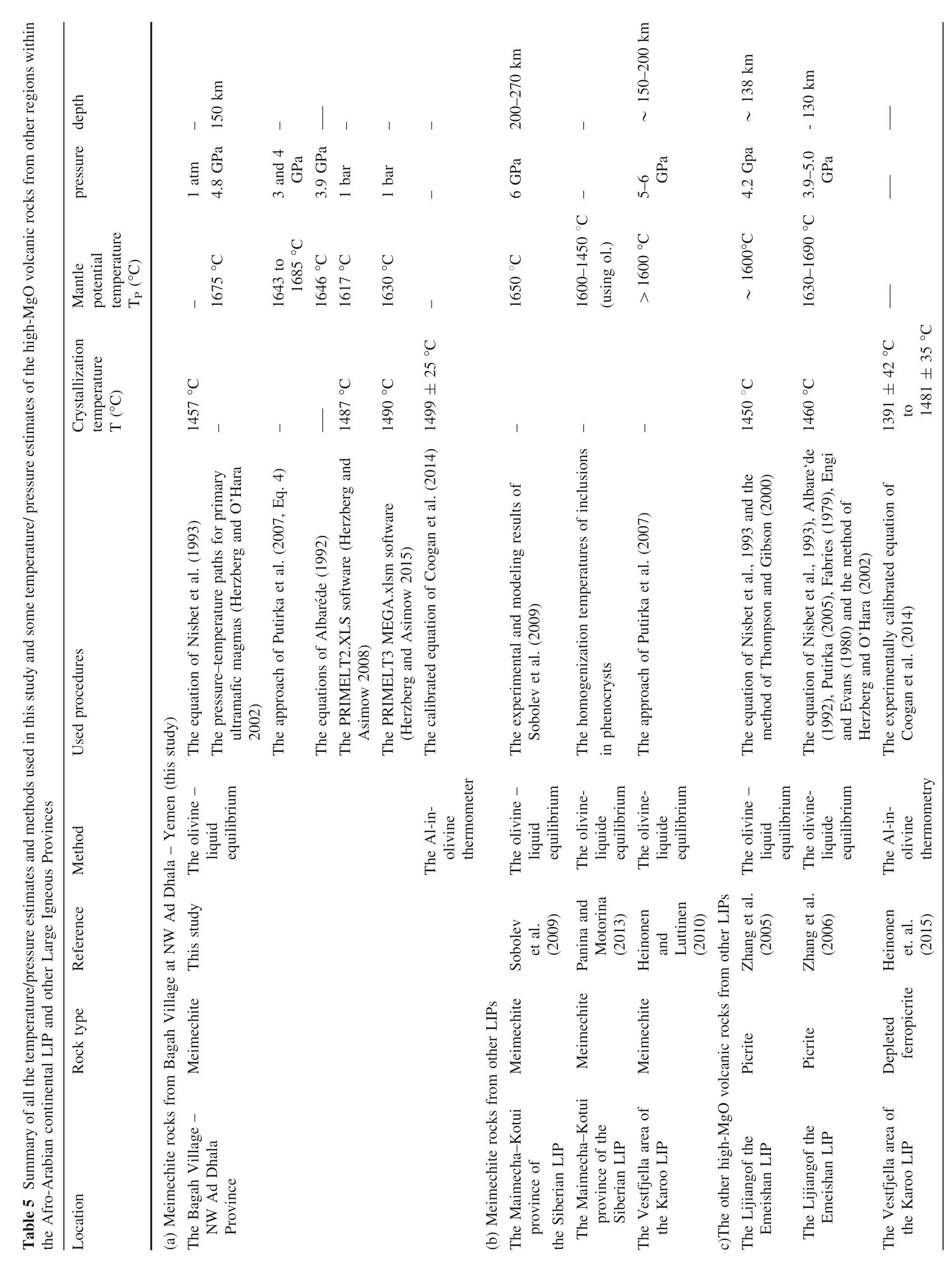
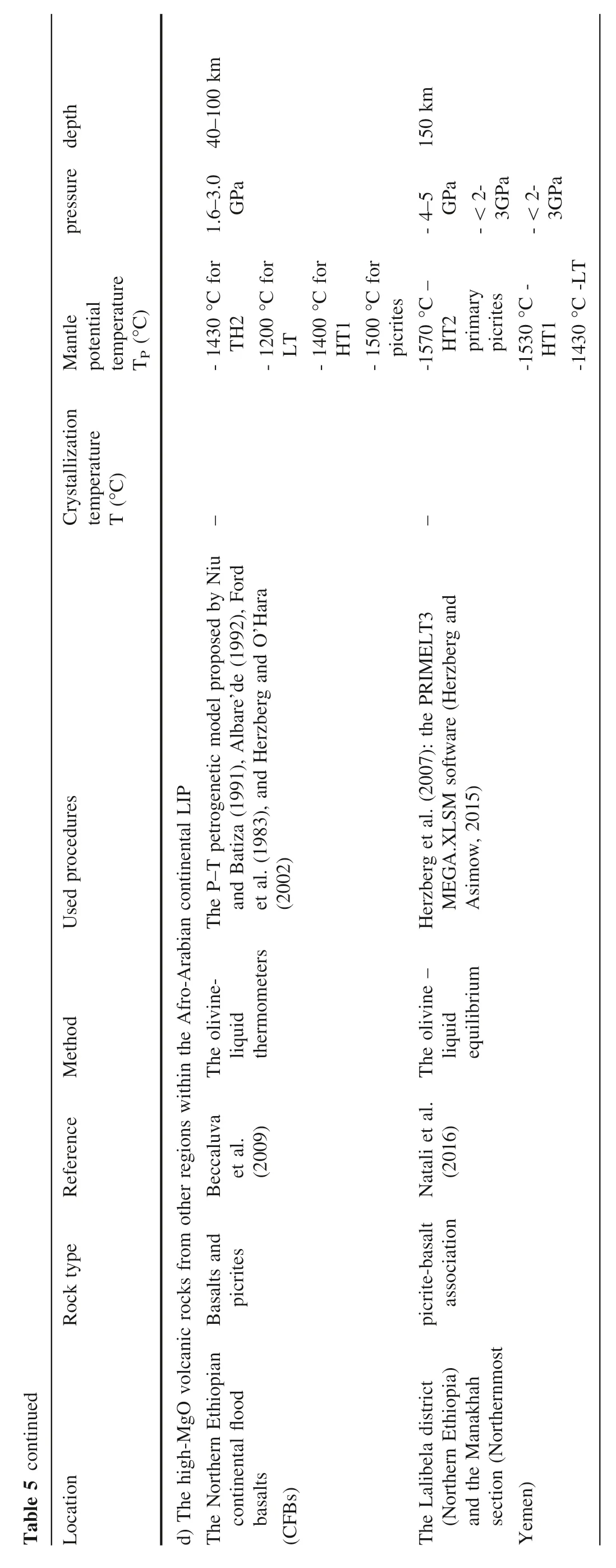
The estimated crystallization temperatures(1450–1490 °C) and potential mantle temperatures(1617–1677 °C) for the studied meimechite rocks are higher than that of the maximum MORB values(1270 °C—Coogan et al.2014),the average of potential mantle temperature beneath MORBs (1454 ± 81 °C,Putirka et al.2007),the global potential asthenosphere mantle temperature (1280–1350 °C—McKenzie et al.1988)and the ambient mantle temperature(1300–1400 °C—Farnetani et al.1994;Herzberg et al.2002;Herzberg et al.2007),which suggests that the generation of the primitive magmas of the meimechites from Ad Dhala province is related to a mantle plume,because the normal mantle (not affected by thermal plume) cannot reach such high estimated temperatures.Hence,this substantiates the existence of the thermal mantle plume (Afar plume) and its important role in the genesis of studied meimechite rocks.
The summary of all the aforementioned temperature/pressure estimates and methods that are used in this study are given in Table 5.In this table,some temperature/pressure estimates of the high-MgO volcanic rocks from other regions within the Afro-Arabian continental LIP(Beccaluva et al.2009;Natali et al.2016) and other Large Igneous Provinces (Siberia,Karoo,and Emeishan) (Zhang et al.,2005,2006;Sobolev et al.2009;Heinonen et al.2010,2015;Panina et al.2013)are shown for comparison.From the data presented in Table 5,the following features should be noted:(a) The estimated crystallization temperature and mantle potential temperature (Tp) of studied meimechites are (1450–1490 °C) and (1617–1677 °C),respectively,at high pressure (3–4.8 GPa).(b) The estimated mantle potential temperature (Tp) of meimechite rocks from other LIPs (Siberian and Karoo) are(1450–1650 °C) at high pressure (5–6 Gpa).(c) The estimated crystallization temperature and mantle potential temperature(Tp)of other high-MgO volcanic rocks(picrite and ferropicrite) from other LIPs (Karoo and Emeishan)are (1391 ± 42 to 1481 ± 35 °C) and (1630–1690 °C),respectively,at high pressure (3.9–5 Gpa).(d) The available estimated mantle potential temperature (Tp) of the high-MgO volcanic rocks (picrite) from Yemen and Ethiopia are(1430–1570 °C)at high pressure(1.6–5 Gpa).Accordingly,the studied meimechite rocks and other meimechite and high-MgO volcanic rocks form other LIPs(Siberia,Karoo,and Emeishan)and from the Afro-Arabian LIP were generated at great depths(~150–200 km),high pressure (~3–6 Gpa) and all shared the extremely high mantle potential temperature (Tp 1500 to 1700 °C).This leads us to conclude that all these rocks were derived from similar mantle sources under similar melting processes that are compatible with the involvement of an upwelling thermal mantle plume.Furthermore,the comparison of studied meimechite rocks with other high-MgO volcanic rocks within the Afro-Arabian LIP supports the important role of Afar plume in the formation of these high-MgO ultramafic rocks and other volcanic rocks that constitute the Afro-Arabian LIP.
In summary,based on the different olivine-liquid equilibrium methods and the Al-in-olivine thermometer approach the estimated crystallization temperature and mantle potential temperature (Tp) of studied meimechites are (1450–1490 °C) and (1617–1677 °C),respectively,at high pressure (3–4.8 GPa).These high temperatures support the derivation of studied meimechites from anomalous hot mantle material related to Afar plume.
4 Conclusions
Based on the chemical compositions of olivine and Crspinel minerals from the meimechite rocks from Bagah Village,NW Ad Dhala-Yemen,we present the following conclusions:
1.The olivine crystals are characterized by high forsterite,ranges from Mg-rich core (ranges from Fo82to90with the majority between Fo86and88)to relatively Ferich rim (down to Fo78.57),high CaO,MgO and MnO with relatively high NiO whereas the Cr-spinel crystals have Cr# values ranging from 0.49 to 0.63 and high TiO2.These compositional characteristics are typical of volcanic olivine and Cr-spinel that formed in intraplate tectonic setting and indicate that they are crystallized from primary magma,i.e.they are not mantle-derived xenocrysts.
2.The primary melt calculations based on the most magnesian olivine phenocryst (Fo89.69) and the composition of the most Fo-rich olivine phenocrystscontaining sample (B6)using PRIMELT3 MEGA.xlsm software,suggest the generation of studied meimechites from high MgO-rich melts (MgO~23 wt.%).This highly magnesian primary magma is a strong indicator for the derivation of studied meimechites from a predominantly garnet-peridotite mantle source and regarded as the primary evidence for a mantle plume origin of the large igneous provinces(e.g.Siberia,Karoo,and Emeishan).
3.The olivine composition and whole-rock compositionbased on parameters (PX# and FC3MS parameters)indicate the derivation of studied meimechite rocks from a peridotite mantle source by small degrees of partial melting under high conditions of temperature and pressure at great depths,mostly within the garnet stability field.
4.Based on the olivine-liquid equilibrium methods using the most Fo-rich olivine phenocrysts-containing sample,the obtained crystallization temperatures range from 1450 to 1490 °C and mantle potential temperature range from 1617 to 1677 °C,respectively,at high pressure(3–4.8 GPa)and great depths.Also,the Al-inolivine thermometer approach based on the partitioning of Al between coexisting Fo-rich olivine and Crspinel is used and yielded crystallization temperature of about 1499 ± 25 °C.These high temperatures are higher than that of the maximum MORB values,the global potential asthenosphere mantle temperature,and the ambient mantle temperatures and substantiate the existence of the Afar thermal plume and its important role in the genesis of the studied meimechite rocks.
AcknowledgmentThe authors would like to express their sincere gratitude to Professor Shoji Arai,who facilitated the achievement of electron microprobe analyses for the olivine and Cr-spinel from studied meimechite rocks at the Department of Earth Sciences,Faculty of Sciences,Kanazawa University,Kanazawa,Japan.Also,great thanks are due to my colleague Dr.Mohammed Hail Hakimi for his faithful help.
Compliance with ethical standards
Conflict of interestOn behalf of all authors,the corresponding author states that there is no conflict of interest.
杂志排行
Acta Geochimica的其它文章
- Variations of methane stable isotopic values from an Alpine peatland on the eastern Qinghai-Tibetan Plateau
- Quantifying aluminosilicate manganese release and dissolution rates across organic ligand treatments for rocks,minerals,and soils
- Concentration determination of gold nanoparticles by flame atomic absorption spectrophotometry
- Evaluating soil erosion by water in a small alpine catchment in Northern Italy:comparison of empirical models
- Pressure calibration and sound velocity measurement to 12 GPa in multi-anvil apparatus
- Zinc,copper,and strontium isotopic variability in the Baiyangping Cu–Pb–Zn–Ag polymetallic ore field,Lanping Basin,Southwest China
